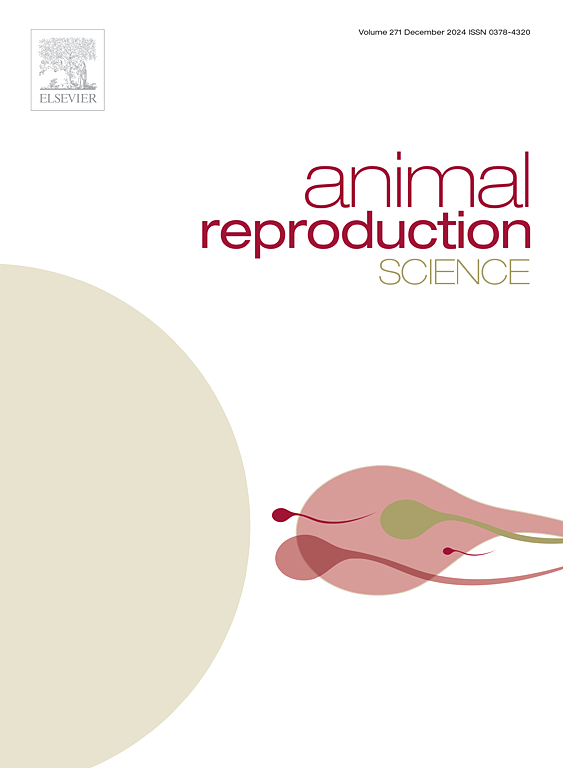Schisandrin B mitigates oxidative damage in early porcine embryos exposed to Ochratoxin A via NRF2 pathway activation
IF 2.2
2区 农林科学
Q1 AGRICULTURE, DAIRY & ANIMAL SCIENCE
引用次数: 0
Abstract
Ochratoxin A (OTA), a mycotoxin produced by Aspergillus and Penicillium species, exerts toxic effects on reproduction and embryonic development through oxidative stress. Although OTA contamination in animal feed is a well-recognized threat, effective protective strategies remain limited. Schisandrin B (Sch-B), a bioactive lignan derived from Schisandra chinensis, is known for its potent antioxidant activity. This study investigated whether Sch-B could alleviate OTA-induced oxidative damage in porcine preimplantation embryos. Porcine zygotes were cultured in vitro with OTA (0.5 mg/L) and/or Sch-B (1 mg/L), and developmental competence, oxidative stress, mitochondrial function, apoptosis, and NRF2/KEAP1 signaling were assessed. OTA exposure significantly reduced cleavage and blastocyst formation rates, increased ROS and MDA levels, and impaired mitochondrial membrane potential. In contrast, Sch-B treatment restored embryonic development, decreased ROS accumulation, increased glutathione (GSH) levels, and improved mitochondrial function. Moreover, Sch-B upregulated NRF2 expression and downregulated KEAP1, indicating activation of the NRF2-mediated antioxidant pathway. Apoptosis assays and mRNA analysis revealed that Sch-B attenuated OTA-induced cell death by modulating the expression of pro- and anti-apoptotic genes. Co-treatment, however, did not fully restore all parameters to control levels, suggesting that higher Sch-B concentrations or additional interventions may be needed. These results demonstrate that Sch-B mitigates OTA-induced oxidative stress and supports early embryonic development via NRF2 pathway activation. Sch-B represents a promising candidate for improving in vitro embryo culture conditions and counteracting mycotoxin-induced reproductive toxicity.
五味子素B通过激活NRF2通路减轻赭曲霉毒素A暴露的早期猪胚胎的氧化损伤
赭曲霉毒素A (Ochratoxin A, OTA)是一种由曲霉和青霉产生的霉菌毒素,通过氧化应激对生殖和胚胎发育产生毒性作用。虽然动物饲料中的OTA污染是一个公认的威胁,但有效的保护策略仍然有限。五味子素B (Schisandrin B, Sch-B)是一种从五味子中提取的生物活性木脂素,以其强大的抗氧化活性而闻名。本研究探讨Sch-B是否能减轻ota诱导的猪着床前胚胎氧化损伤。用OTA(0.5 mg/L)和/或Sch-B(1 mg/L)体外培养猪受精卵,评估发育能力、氧化应激、线粒体功能、细胞凋亡和NRF2/KEAP1信号。OTA暴露显著降低了卵裂和囊胚形成率,增加了ROS和MDA水平,并损害了线粒体膜电位。相反,Sch-B处理恢复胚胎发育,减少ROS积累,增加谷胱甘肽(GSH)水平,改善线粒体功能。此外,Sch-B上调NRF2表达,下调KEAP1,表明NRF2介导的抗氧化途径被激活。凋亡实验和mRNA分析显示,Sch-B通过调节促凋亡和抗凋亡基因的表达来减轻ota诱导的细胞死亡。然而,联合治疗并没有将所有参数完全恢复到控制水平,这表明可能需要更高的Sch-B浓度或其他干预措施。这些结果表明,Sch-B可以减轻ota诱导的氧化应激,并通过NRF2通路激活支持早期胚胎发育。Sch-B是改善体外胚胎培养条件和对抗真菌毒素诱导的生殖毒性的有希望的候选者。
本文章由计算机程序翻译,如有差异,请以英文原文为准。
求助全文
约1分钟内获得全文
求助全文
来源期刊

Animal Reproduction Science
农林科学-奶制品与动物科学
CiteScore
4.50
自引率
9.10%
发文量
136
审稿时长
54 days
期刊介绍:
Animal Reproduction Science publishes results from studies relating to reproduction and fertility in animals. This includes both fundamental research and applied studies, including management practices that increase our understanding of the biology and manipulation of reproduction. Manuscripts should go into depth in the mechanisms involved in the research reported, rather than a give a mere description of findings. The focus is on animals that are useful to humans including food- and fibre-producing; companion/recreational; captive; and endangered species including zoo animals, but excluding laboratory animals unless the results of the study provide new information that impacts the basic understanding of the biology or manipulation of reproduction.
The journal''s scope includes the study of reproductive physiology and endocrinology, reproductive cycles, natural and artificial control of reproduction, preservation and use of gametes and embryos, pregnancy and parturition, infertility and sterility, diagnostic and therapeutic techniques.
The Editorial Board of Animal Reproduction Science has decided not to publish papers in which there is an exclusive examination of the in vitro development of oocytes and embryos; however, there will be consideration of papers that include in vitro studies where the source of the oocytes and/or development of the embryos beyond the blastocyst stage is part of the experimental design.
 求助内容:
求助内容: 应助结果提醒方式:
应助结果提醒方式:


